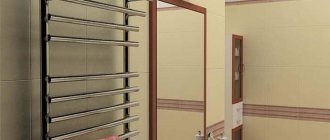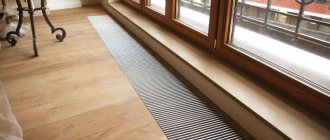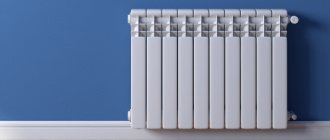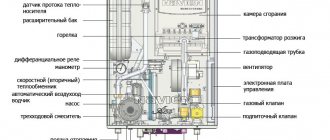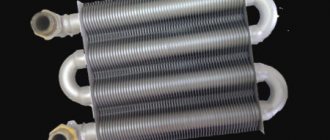I’ll immediately answer the question: is it possible to install a heating radiator instead of a heated towel rail? The answer here is clear - yes, it is possible. Such a replacement is quite affordable and depends only on the wishes of the owner. In this situation, I consider another question more logical: “Why and how is this done?” You will get answers to this in this article.
Source art-liga.rf
Heating appliances in the bathroom
The heated towel rail performs the function of heating the bathroom.
There is no doubt that a battery is needed in the bathroom, but why is it there? We are talking about an ordinary radiator that is in every room. In the bathroom, the heated towel rail is mainly used as a heating device. This is, in fact, a water heating register, whose main function is heating. This means that he is also a kind of battery.
The bathroom is small, so a towel is usually enough. In large bathrooms, the power of a heated towel rail will not be enough; in this case, it is necessary to install a battery in the bathroom. Suitable for this:
- Steel batteries;
- aluminum radiators;
- bimetallic radiators.
The latter are the most practical and reliable. But it also happens that you inherited a cast-iron radiator in the bathroom along with the apartment. Previously, they weren’t particularly worried about making it beautiful. The main thing is quality and durability, so we installed ordinary cast iron radiators in three sections in the bathroom. Usually they are replaced with either a water heated towel rail or a combined unit (battery + heated towel rail). Here you need to look at the heat loss of the room.
Replacing a heated towel rail in the bathroom with a radiator and the consequences of this replacement.
- home
- Articles
- Replacing a heated towel rail in the bathroom with a radiator and the consequences of this replacement.
30.01 2008
Time regularly receives letters of this kind:
“In my apartment there was a very inconvenient heated towel rail - a crooked pipe under the washbasin. Instead, I installed several sections of a bimetallic radiator. A year later, the radiator rusted and leaked in several places, flooding the lower neighbors. I was told that bimetallic radiators are the most reliable. It turns out they were deceiving?
Our technical consultant Oleg Sizukhin answers: “The reason for your trouble is that you used a bimetallic radiator in conditions that are strictly contraindicated for the radiator (as, indeed, for almost all heating devices).
In typical urban residential buildings, heated towel rails (HS) are included in the hot water supply system (DHW). This is due to the fact that hot water is supplied to residential buildings almost all year round at a relatively constant temperature. Heating is seasonal, and the temperature of the heating water is set depending on the outside air temperature. The water in hot water systems is very aggressive - it has a high temperature and most often has a high oxygen content.
The designs of heated towel rails take these corrosion factors into account. PS is made from corrosion-resistant materials - stainless steel, brass or thick-walled steel water pipes. of cast iron radiators were installed as PS - the material is also very resistant to corrosion. When you installed a radiator in place of the previous PS, you put it under very difficult operating conditions.
The devices of most heating devices are designed to operate in closed heating systems with a low content of oxygen dissolved in the water. To remove air from water in heating systems, even special deaeration systems are installed. The thickness of the walls of the steel tubes of bimetallic radiators is quite sufficient for reliable operation in heating systems, but absolutely not enough for a heated towel rail. That’s why your radiator rusted and leaked so quickly. If you decide to replace the old PS with a new one, change it only to a factory-made stainless steel PS. As a last resort, several sections of a cast iron radiator can be installed as a PS. Will the radiator last a long time, but will it please the eye in the interior of a modern bathroom? You should know that the heat transfer of the substation can be adjusted only if a bypass (jumper) is installed on its connections. Otherwise, you risk shutting off the water throughout the entire hot water riser.”
To the list of articles
Other articles
16.05 Energy efficient water heaters HAJDU
28.12 “Superpipe” in the service of the people. XLPE pipes produced by METZERPLAS (Israel)
21.11 RETRO cast iron radiators are always in demand. The solution to modern heating in the style of antiquity and sophistication can be a cast iron radiator, the artistic casting of which was created according to drawings and drawings from the turn of the century.
25.10 Review of Bosch gas instantaneous water heaters
Do you need a heating radiator for your bathroom?
It would seem that the question is rhetorical, of course, necessary. Nowadays, when every second citizen has a higher education, there is no need to explain that the bathroom is classified as a room with a high level of humidity. Therefore, you need a heating device that can not only function flawlessly in such conditions, but is also capable of creating comfortable conditions in the bathroom.
We will still remind you of the tasks that a heating radiator in a bathroom successfully copes with:
- Heating the room.
- Speeding up the drying process.
- Preventing mold and mildew.
- Comfortable microclimate when carrying out hygiene procedures in the cold season.
In standard bathrooms, in addition to a heated towel rail, three or four additional sections of heating radiators are usually installed. This applies to almost the entire territory of Russia, except, of course, the southern regions, where winters are quite mild.
If the bathroom is insulated and equipped with a heated floor system, then installing a radiator in the bathroom may not be necessary. In the case of low floor heating power or its complete absence, it makes sense to install not only radiators, but also a heated towel rail. The latter is usually connected to hot water pipes (if there is one), or another option is an electric “towel”. In general, there are a lot of modifications, the decision is yours, and we will consider the question of the need for heating closed.
Heated towel rail or radiator?
First, let's understand the terminology: heated towel rail or radiator? At first glance, these are the same thing, but in fact these devices differ fundamentally.
Heated towel rail
To greatly simplify, we propose to divide it as follows: a heated towel rail is a bent pipe (a structure of welded tubes) through which hot water flows, the same that is then supplied to the mixer, that is, the device is built into the hot water supply system (DHW) of the building. Heated towel rails powered from the hot water supply line are a traditional heating device for the post-Soviet space in the bathroom. The water of the hot water supply system imposes restrictions on the material of the product, and today heated towel rails are mainly made of stainless steel on the Russian market.
To be fair, we note that especially for the CIS countries, global heating industry brands are developing their limited model lines made of stainless steel, copper or brass, but the price for them, as a rule, starts from several tens or even hundreds of thousands of rubles.
The main argument when choosing the simple heated towel rails that are familiar to us is, first of all, that hot water from the hot water supply supplies the device all year round. But this is not for everybody: is a heater with a constant temperature of 55-60 °C really necessary in the summer, when it is 25-40 °C above zero outside? And the second question: why should the owner of a house without a central hot water supply or boiler system become attached to an expensive, limited in size and controversial from a design point of view nickel-plated product?
The range of relatively inexpensive models (as far as possible when using non-ferrous metals), designed for the mass consumer, is quite scarce and is represented by variations of the small classic “ladder” or “snake”. Manufacturers' design experiments are limited
Radiator
A bathroom radiator, due to the fact that it operates in a heating system with normal coolant parameters, has no restrictions on the material. As a rule, all Western European manufacturers make radiators of this type from low-carbon steel, prepare them for use in wet rooms, paint them in any color or supply them in chrome. In this form, radiators in bathrooms and showers function without any restrictions for decades. The bathroom radiator is perceived all over the world as an inexpensive, convenient, functional and stylish design element. Technologically and in terms of location, it is not tied to the general house hot water riser, which means it can decorate any bathroom wall and is free from a number of typical “diseases” of the public circuit, such as stray currents, airing, clogging/overgrowing with deposits, and the inability to regulate the temperature of the device.
The variety of shapes and sizes of a modern bathroom radiator is dictated by the malleability of a material such as steel; the market also offers dozens of inexpensive and stylish accessory models
A radiator in the form of a classic “ladder” looks more harmonious, and will be one and a half to two times cheaper than a similar-sized heated towel rail made of non-ferrous metal. And if we compare more or less interesting design models of steel and nickel-plated analogues, produced in both cases only in the West, then the difference in price can be up to five times!
For year-round operation of a steel bathroom radiator, if necessary, options combined with an electric heating element are widely used. In this version, in winter and in the off-season, the radiator operates from the heating system, and in the summer it warms up from a compact and economical built-in heating element.
Which option is better? As you can see, in both cases there are obvious pros and cons. DHW heated towel rails are ours, dear, familiar. It is quite difficult for us to imagine that a heating device in a bathroom could be colored, unusually large or designer. This does not mean that one of the directions is definitely better, it’s just that our heated towel rail grew out of a U-shaped outlet from the hot water supply, and for them it grew out of a heating device in the bathroom. The choice is yours!
EXPERT OPINION
Lali Surmava, interior designer (Krasnodar):
— The bathroom is the place where your day begins. It creates the mood of the day, and it also helps you relax in the evening. That is why it is important that the interior of the bathroom is “to your liking”. This means that when planning the bathroom space, you need to spend more time on design and accessories. Today, foreign and domestic manufacturers offer a wide range of sizes, shapes, colors and designs of radiators and heated towel rails for the bathroom. In addition to their direct functions - maintaining temperature, protecting the room from over-humidification, drying towels and linen - today they carry a valuable aesthetic value. A bathroom will look dull and uncomfortable if it does not have a variety of textures. Their interaction - the contrast of surfaces and colors - gives the interior energy and makes it original.
Requirements for bathroom heaters
To ensure that the bathroom always has a comfortable temperature, it is necessary to select equipment that meets certain comfort requirements:
- Each heater must be adapted to operate in wet conditions. This suggests that it is necessary to choose a device that is protected from splashes. It is also necessary to ensure that the heater is covered with an anti-corrosion layer, otherwise it will not be possible to avoid the appearance of rust, which will spoil the appearance of the equipment, and over time, completely render it inoperable.
- Equipment located in the bathroom should take up little space, since usually this room is not the largest in size in the house. Each area in the bathroom has a specific purpose, and it will be extremely inconvenient to purchase a large heating device that fills the entire space.
- The equipment must have the necessary power to heat a particular room.
- The power of the device must be safe for rooms and people who will often be in the bathroom. This is especially true for children
- A heater located in a bathroom should look aesthetically pleasing and beautiful. It is advisable to select equipment that ideally matches the style of the already created interior, so that the overall background of the room does not deteriorate. In most cases, people buy devices in white or blue.
The bathroom heater must be adapted to work in humid conditions
Types of heating devices for the bathroom, their capabilities
There are many types of heaters for the toilet and bathroom:
- water heating radiator;
- electric convector;
- infrared heater;
- heat fan;
- panel heater;
- oil radiator.
The choice of heater model depends on the size of the bathroom and technical capabilities
Heating batteries
Coils and wall radiators for heating
This includes both heated towel rails and conventional heating radiators, which are found in kitchens, living rooms and bedrooms. There are many options to choose from:
- A water-based heated towel rail is a good solution for small forms. But using it to heat a large-format bathroom will be quite difficult;
- Electric heated towel rail - convenient, beautiful, expensive. Such a device requires large financial costs or can be combined with other types of heating: a water coil, a radiator, or a “warm floor” system. True, it all depends on the area of the room;
- Aluminum radiators are lightweight structures that provide greater heat transfer. When connecting the battery to a hot water riser, be sure to weld the gas outlet pipes: aluminum releases a certain amount of gas when in contact with boiling water.
Advice! The battery joints must be soldered! This is the only way to ensure tightness when pressure increases in the pipes and resist corrosion. In addition, soldering looks more aesthetically pleasing than any other type of connection.
- The cast iron battery is a budget option. Resistance to damage, durability and long service life are clear advantages of the radiator. But low heat transfer and heavy weight are not always good for the bathroom.
- A steel battery is a fairly practical heating element. High heat transfer, ease of installation, increased thermal inertia - all these are the advantages of this radiator. Some problems can only be caused by the sensitivity of the metal to draining water.
- Bimetallic structures are expensive, but very practical bathroom heating. This is the best option that combines all the pros and has no cons.
Advice! When choosing a chrome-plated steel version of the battery, remember that such a heater has a reduced heat transfer (by almost 35%), so it is better to select a radiator of greater power and size. And the chrome surface does not tolerate water vapor from household chemicals well (stains remain).
Heating materials
We will not start a debate here about the effectiveness of this or that radiator material, or provide formulas and calculations of heat capacity and heat transfer. This topic requires a separate article, and if you describe the calculation and production of heating batteries with your own hands, then several.
We recommend: Do-it-yourself Buleryan oven, photos, videos, diagrams and drawings
In the end, in the end, it is not the material that is put into the heating system, but a specific product with well-known characteristics. Parameters of almost any model can be found in manufacturers’ catalogs and tables.
Nevertheless, let’s get acquainted with the main types of heating devices:
- Cast iron - it is believed that such batteries are durable and have good heat dissipation. But, if you look at it, having the largest dimensions among all heating devices, they provide the least heat transfer. For vintage lovers, this is just the thing.
- Steel ones are not a very good choice of heating device for the bathroom. A humid environment causes pockets of corrosion on the body of the sections; over time, these areas can leak. Based on their design, housings are divided into panel and tubular.
- Aluminum - have a good design and low weight. According to many experts, such batteries are an ideal choice for a bathroom in a house with individual heating. Owners of apartments with a centralized heating system should pay attention to reinforced models that can withstand significant water hammer and the influence of low-quality coolant.
- Bimetallic - structurally, the devices consist of a steel frame with an aluminum casing. They are assembled taking into account the characteristics of central heating networks. Average service life is 20-25 years. It happens that bimetallic radiators do not heat well due to installation errors, but this can be easily fixed.
- Copper ones have not yet been widely used in our country due to special installation and operating conditions. The cost of such devices is quite high, although they have plenty of advantages. There are also some restrictions, for example, manufacturers do not recommend installing copper batteries in networks that contain high amounts of chlorine salts.
When choosing heating devices for the bathroom, consider not only the characteristics, but also the design in order to fit them as harmoniously into the overall interior as possible. In general, judging by the manufacturers' data, the heat transfer of batteries made of any materials except cast iron is almost the same, the difference is literally within 5%.
With cast iron equipment, things look different. If we bring the depth of a section of a bimetallic or aluminum radiator (80-100 mm) to the depth of a cast iron one (140 mm), then the heat transfer of the latter will be ⅓ lower.
From all of the above, the conclusion suggests itself: the material does not have a significant effect on the thermal efficiency of the device, with the exception of cast iron. Therefore, when buying a heat exchanger, it is better to look at its cost, dimensions, and quality. And finally, don’t lose sight of its appearance, so that you don’t have to worry about how to cover the radiator in your bathroom.
Infrared heaters: efficient heat
The difference between an infrared device and others is that it is mounted on the ceiling, but it warms not the air, but the floor and walls of the room. The product consists of a quartz emitter - a special plate that emits heat, heating up to 260 degrees. Such a heater takes up practically no space; when heated to a certain limit, it turns off on its own.
When choosing an infrared panel heater, you need to make sure that the model is designed for rooms with high humidity
The most interesting feature of the device is that the direction of the rays can be easily adjusted, heating the desired place, which is especially convenient in spacious rooms and allows you to use electricity economically. A high level of humidity is not harmful to the product, and the high cost will be compensated by the benefits received from use.
Electric convector
In this heater, as in many others, the heating element is made of a powder composition with a thin heating filament made of nichrome. The housing is made of silumin, the design itself is modular (allows you to change the power level and dimensions of the device), wall-mounted.
Operating principle of a convector heater
The temperature is controlled using a thermostat, the internal heating level is 350 degrees, the housing is 55. The product is highly electrically safe and is suitable for heating wet rooms.
Wall-mounted models of electric convectors are designed for the bathroom
A variety of similar heaters are also produced that operate without infrared radiation - completely silent, outwardly resembling a fragment of horizontal blinds.
Fan heater
A simple and convenient bathroom fan heater, extremely affordable, quickly warms small spaces. The power of the device is 2000-2500 W, the dimensions are minimal, the shape is different. The design consists of a fan in a plastic casing with a spiral heating up to 800 degrees. Heat is distributed throughout the room by a fan, quickly warming up the room.
Fan heaters are available in various capacities and sizes, including built-in models.
Fan heaters for any bathroom area are very compact, light in weight, and easy to install on the floor, wall, furniture surfaces and window sills. The main advantages are light weight and size, beautiful appearance, ease of operation. Disadvantages - the operation process is noisy; if it is poorly maintained (if a lot of dust has accumulated on the device), it has an unpleasant odor.
Oil radiator
Models of oil radiators for the bathroom
A simple, familiar and ordinary heater that is found in almost every home. You can create heating in the bathroom using a radiator if you choose the right power. The design has the following advantages:
- Safety - even if a newspaper falls on the radiator, nothing bad will happen; the absence of open heating elements allows such missteps;
- Mobility - the light weight and shape of the device are good when you need to move the radiator to another room or remove it altogether;
- Does not burn oxygen - this is a very important fact, especially for small bathrooms.
Important! Many radiators are equipped with temperature controllers, programmable timers and LCD indicators. All these additions are necessary if you want to set the program and keep your bathroom warm without unnecessary hassle for a long time.
Liquid heated towel rails
Since any bathroom needs a heated towel rail, it is necessary to choose this item wisely. The traditional type of liquid heated towel rail is a curved pipe that connects to the home's water system. Thus, you can get a heating device that not only warms up damp things, but also maintains the optimal temperature in the room.
We recommend: How to clean chimneys in a stove using folk remedies: how to clean a chimney
The heat transfer from the dryer is not too great, and therefore the design does not include radiating surfaces or ribs that form upward heat flows.
A heated towel rail is an ordinary curved pipe, the diameter of which is comparable to that of a water pipe. The device can also be a ladder consisting of a certain number of elements. Hot water will flow inside the pipe, with the help of which a towel or things can be dried in a fairly short time, while creating a comfortable temperature inside the bathroom.
Liquid heated towel rails for heating the bathroom
From this we can conclude that the equipment is very useful in winter, but it is worth noting that when cold water flows through the pipes, the heated towel rail becomes useless - no heat will be received. You also need to know that such devices often become corroded. The fact is that tap water contains oxygen, and because of it, this process accelerates. When the hot water supply is turned off, the cold pipe will become covered with condensation, which can soon cause corrosion build-up.
Cable heated towel rails
A cable heated towel rail is equipment with a built-in cable, which resembles the one found in a heated floor system. But unlike the “floor”, electricity consumption is noticeably lower.
The cable version has a more original design than other types of bathroom heaters. This type of equipment is cheap because there is no need for increased tightness compared to the liquid model.
The cable type is also very easy to place at the workplace, since there is no need to connect heating elements to it, which are usually located at the bottom of the case. This suggests that the equipment is located in both a diagonal and vertical plane. The heated towel rail heats up very quickly, but at the same time it cools down quickly after switching off - this is a minus.
Warm floor - thoroughly and for a long time
For those who do not like half measures, there is another option for heating the bathroom - heated floors. It is advisable to ensure that the heated floors in the bathroom work autonomously and are not dependent on neighboring rooms, since the bathroom needs year-round heating, while in other rooms it is needed only in the cold season.
Engineering provides services for the development, management, and consulting of engineering and technical projects. In particular, the development of design documents for the construction of gas boiler houses and mini-CHPs with a feasibility study for construction and other design and construction documents. The design of gas boiler houses - TsMIP SGUU is carried out by high-level designers with extensive experience in carrying out various works and calculations that meet all modern requirements for projects of this type.
Classification of heated towel rails
Dryers are divided into different groups according to type, size, installation method and material.
By type of coolant connection
The type of connection also determines three types of heated towel rails, and the type of connection plays one of the key roles when choosing a specific model.
- Water heated towel rail. Connects to the hot heating system. Heating occurs during the passage of a heated working environment. It is important to choose a model made of material that is resistant to aggressive water. During operation, there may be a risk of destruction of the structure of the internal walls, so the level of rigidity is an important factor when choosing . Made from stainless steel with a chrome finish , this is an excellent option that will last for many years.
- Electric heated towel rail. Does not depend on central heating . Requires an outlet at the installation site. Allows you to use yourself when necessary. There is a function for self-regulation of temperature data. Characterized by increased energy consumption.
- Combined heated towel rail. The most practical scheme for installation at home. You choose the connection type that is convenient for you. Alternating the heating method is optimal in different seasons of the year. So, you save money on utility bills. The cost of this modification is an order of magnitude more expensive than the above analogues.
Divided by size format
This variety is more of a design definition than an actual characteristic; it all depends, trivially, on the ratio of height and width.
- Horizontal heated towel rail. Combines the features of a dryer and radiator for heating. Installed as a window sill option. Will fit into any design. Does not take up a large area during installation.
- Vertical heated towel rail. It takes up an order of magnitude more space to be placed on the wall. Provides a large usable drying area. Available in exclusive shapes that will make your home decor stand out.
Type
There are 3 types:
- Mermen. Powered by hot water. The advantages include durability, strength, no additional maintenance costs, and low cost. There are no maintenance requirements; replacement is required primarily not due to breakdown, but for aesthetic reasons. The disadvantage is the dependence on hot water supply or heating (to which the dryer is connected). Some devices only work in winter, when the apartment is heated. Others become cold when there is no movement of hot water through the pipes.
- Electric ones are connected to the network for continuous operation. Their disadvantage is expensive maintenance. They are easier to install than water ones, because you don’t need to drill the walls, connect to the water supply, or use additional fittings.
- Combined ones combine the characteristics of both types. These heated towel rails are connected to both a hot water source and an electrical outlet. The ability to change modes allows you to always maintain a comfortable room temperature.
We recommend: How to thaw a frozen water supply: a review of the best methods
By material
Dryers are made from different materials:
- Stainless steel will withstand high pressure. The walls of the pipe must be at least 3 mm thick.
- Steel is a cheap material. Dryers made from it are no longer sold, but most old houses have them installed.
- Copper is resistant to corrosion and conducts heat well. Such a product will not be heavy and looks good in appearance. Check that the pipe is galvanized on the inside for greater protection against water. The disadvantage of this option is the expensive price.
- Brass has the same “advantages” as copper. Products made from it are cheaper. The "disadvantage" is fragility. You should only buy dryers with chrome-plated inner walls.
Other non-ferrous metals and alloys (for example bronze) can also be used. Such products are rarely used due to their high cost.
Non-ferrous metals are often used to create designer dryers of non-standard shapes and colors.
Choosing a water heated towel rail
Choosing the right heated towel rail is a whole science, and especially a water one. The most important thing here is the shape, size and even the location of the bends, and there are also technical characteristics that also need to be taken into account.
Modern heated towel rail
Specifications
The operating pressure in the DHW system should be in the range from 0.3 atm to 6 atm. The pressure in the centralized heating system greatly depends on the area, but is rarely higher than 10–12 atm (in high-rise buildings). Select water dryers according to these parameters.
Before choosing a heated towel rail, pay attention to such an indicator as the maximum temperature. For hot water supply, this figure is rarely higher than 60 °C; for heating, few people give 80 °C. From this point of view, all stainless steel dryers are suitable, they have a maximum temperature of about 105–110 °C. Nevertheless, emergency situations occur when water is supplied heated to a hundred degrees or even higher, so this reserve will not hurt.
Deciding on the form
Water towel dryers come in different shapes. They can be divided into several groups:
- U or U shaped. The simplest in form and having the lowest cost. The disadvantages include their small “usable” area, as well as the not very large amount of heat that they can generate. You can't hang a lot of things on them. But such a towel dryer in the bathroom, with the correct size selection, can “stand” in the place of an old similar shape without modification.
- Snake, coil or M-shaped. A slightly more complex shape, more usable area and heat generated. They are also not very difficult to connect and have a low price. Snake dryer. Maybe not a masterpiece, but it lasts a long time
- Ladder. A heated towel rail consisting of a number of horizontal bars united at the edges by vertical collectors. The crossbars can be straight or in the form of a snake. Such a device usually has two connection methods - side and bottom. A more complex form requires a well-chosen scheme, otherwise it will not work. In addition, due to the high material consumption, the cost of such dryers is several times higher than coils.
- Non-standard complex shapes. There are unusual towel rails that look more like designer decorations than plumbing fixtures. Their prices are not low, and most of them are delivered “to order”. Problems often arise with their connection, so you need to choose the right circuit and consult a specialist.
Choosing a bathroom dryer according to its shape is both simple and difficult. You need to consider how and where you can install the design you like. At the same time, do not forget that you will have to connect it to a riser, which means pulling pipes along the walls to it. Moreover, most likely, the gasket will be hidden, that is, it will be hidden in the wall, which means that it will be necessary to ditch them or install a false wall.
Connection and installation features
An electric heated towel rail is connected to a regular socket, but since the installation location is a bathroom with high humidity, the voltage must be supplied through an RCD that breaks phase and zero; an automatic circuit breaker is also needed, perhaps one contact. The choice of their electrical parameters depends on what other devices will be connected to this line. It is not worth running a separate line to the heater due to its low power.
Thermostats have different shapes, but the functionality is usually the same
The heated towel rail can be installed anywhere. Usually the protection class allows it to be installed even above a bathtub (II), but this is hardly worth doing. It’s inconvenient, and things will get wet. It is usually best to install an electric dryer on any free wall. Often so that you can reach from the bathtub or shower stall. If the bathroom is combined, you will have to choose. You can also place it not far from the bidet or toilet with a hygienic shower. By the way, mounting brackets are usually included in the kit, so you don’t have to invent anything.
Why, when and how to replace a heated towel rail with a radiator
Most often you want to replace a heated towel rail with a heating radiator when it is cold in the bathroom and the power of the dryer is simply not enough to heat the room. Of course, in the same place you can install another, more powerful heating device intended for drying, but this is the owner’s choice. In addition, this need may be relevant if the bathroom is small, but you need to hang a mirror or wall cabinet on the wall where the dryer is located. Other situations may arise, but this is not the point - I will tell you how to make a replacement.
In an apartment in a multi-storey building
In multi-storey buildings, in 99.9% of cases, a single-pipe heating system is installed - we will not discuss whether this is good or bad, since we are talking about something else now. The riser from which the heated towel rails are powered is located separately from the risers to which the radiators are connected. But in this case, we only need a pipe that runs through all the bathrooms of the house and, as a rule, two neighboring apartments on the site are connected to it. Sometimes (depending on the type of building) only one apartment is powered, but the pipe still remains common. That is, this riser is embedded in the attic (sometimes in an apartment on the top floor) and in the basement.
Source m-strana.ru
According to the project, each heated towel rail fits into a riser without a bypass and serves as a continuation of the vertical pipe. Therefore, if you cut or block the dryer, water will not flow through this riser - you will block these heating devices for all upper and lower neighbors in the house. Therefore, if you decide to just get rid of the heated towel rail, even temporarily, the riser needs to be connected, as shown in the top photo. This means that you will not make any changes to the design of heating communications, and there can be no claims against you.
A vertical pipe may pass through your neighbors’ bathroom, and only pipes for connecting the device will stick out on your side, but this does not mean that you can break the coolant supply chain. Of course, there may be situations when neighbors made repairs and made some changes to the design of communications, that is, for their part, when connecting the pipes to your dryer, they installed a bypass. If so, then dismantling your heated towel rail will not affect the overall system in any way, but you will have to personally verify that there is a bypass, otherwise you will be responsible for disrupting the communication system.
In the private sector
Source teplospec.com
In the private sector, everything is much simpler - you are the master of the situation and can change the communication scheme at your own discretion. However, you still have to adhere to some requirements. For example, if the house has a one-pipe heating system, then you should adhere to the rules discussed above in the section “In an apartment in a multi-storey building,” but only if there is no bypass in front of the heated towel rail. In addition, a dryer in the private sector on a single-pipe circuit is usually connected to the pipe on the side, where the riser or deck itself is the bypass.
With a two-pipe heating system, it is important to determine whether any of the radiators are connected in series with the heated towel rail. In this case, after dismantling one of the devices, it is necessary to restore the coolant supply circuit. It is best when the dryer is not connected in series to direct water circulation and to any battery. When replacing heating devices, correct the situation immediately - in the future it will be easier for you to maintain the system.
Replacing a heating device
Source ekvator.dp.ua
In cases where the wiring of the heating system is made of polypropylene, everything is much simpler, since you do not have to switch from one material to another, so we will consider the option with a metal circuit. In the vast majority of cases, the wiring system in apartments and private houses is made of steel pipes with a diameter of 1/2 or 2/3 inches, therefore, to switch to polypropylene (hereinafter PPR or PPR) you will need fittings - for PPR these are Ø 20 mm and Ø 25 mm. If you want to switch to a different pipe diameter, then you need to use a metal (preferably brass) or propylene solder reduction.
Advice: you should not switch to a larger pipe diameter, for example, from twenty to twenty-fifth, as this makes no sense! In addition, this will reduce the intensity of coolant circulation, which will automatically reduce efficiency.
Source trubanet.ru
For installation of heating in the private sector and apartment buildings, PPR PN-20 or PN-25 is currently usually used. This is not the diameter of the pipes at all, but a marking indicating reinforcement with aluminum foil or fiberglass. PN-25 of any diameter has slightly thicker walls, but practice has shown that PPR PN-20 behaves excellently not only in hot water supply systems, but also in high-pressure heating circuits in high-rise buildings. Here, of course, the choice is yours - I’m just sharing my and other people’s practical observations. There is no PN indicator for PPR fittings, so you don’t have to look for it.
When a radiator is installed instead of a heated towel rail, they usually change the location of the device, that is, lower it lower, because the dryer is usually installed about one and a half meters from the floor. This is connected not only with aesthetics, but also with common sense - warm air rises, so the most effective heating option will be if this path starts from the floor, and not from the middle of the room.
Source montagtrub.ru
When welding hot polypropylene pipes, it is very important to adhere to the provisions indicated in the table above. Such rules are especially relevant for multi-storey buildings, where the nominal or pressure test reaches 9-16 bar. In the case where the soldering is weak (shallow or not sufficiently heated), a leak may occur at high pressure, which is difficult to correct during the heating season.
Recommendation: a leak at the welding site at the height of the heating season can occur if the plumber installing the heating made some mistake. Do not panic. When the leak is minor, it is not at all necessary to drain water from the system to eliminate it. Use cold welding and correct this defect at the end of the season.
Source teplospec.com
The choice of a radiator for a bathroom largely depends on what batteries are installed in the house or apartment. For example, if it is a multi-storey building, then there is, accordingly, high pressure in the heating circuit and then cast iron, bimetal or steel are used. In the private sector, aluminum is possible, but again, only if there are no copper or brass fittings in the circuit, and special liquids are used as the coolant. That is, aluminum will not be suitable not because it will not withstand high pressure, but because the non-ferrous metal will begin to oxidize when interacting with other metals. I also do not recommend steel heaters, as they quickly corrode, which means cast iron and bimetal remain.
